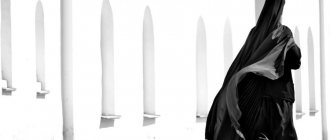Why do Christians get baptized?
The sign of the cross is a special prayer hand gesture with which Christians depict a cross on themselves. This is not just a ritual action or a religious injunction. The cross is the main symbol and spiritual weapon for believers and has a deep meaning. Therefore, it is important to know how Orthodox Christians are baptized.
Orthodox sign of the cross
“But what is the Cross? In a material sense, it is a symbol that we possess. But this symbol cannot be created. What matters is the power that lies in this symbol. With the help of this power, God the Word united those who disagreed and <…> returned our rebellious nature, subject to decay, to balance. He abolished death and the devil, opened the entrance to paradise for people, so that they could return to where they left, could enter there <...> where all the Divine vows are (schemamonk Joseph of Vatopedi).
Why do Orthodox Christians cross themselves with three fingers and has it always been this way?
Share
Photo from open source
The sign of the cross is one of the main symbols of the Orthodox faith. By depicting the sign of the cross on ourselves, we thereby not only strengthen our prayer to God, but also express our belonging to the Orthodox faith. Yes, yes, the sign of the cross has served as a symbol of the true Christian faith since ancient times. At the present stage, Orthodox Christians are baptized this way. We put the thumb, index and middle fingers together, press the ring and little fingers to the palm and thus alternately cover the forehead, stomach, right and left shoulder. We put three fingers together as a sign of faith in the Holy Trinity; two fingers pressed to the palm are a symbol of the Divine and human natures of Christ.
This may seem surprising to some, but the sign of the cross did not always have the form that is familiar to us today. Ancient Christians made the sign of the cross not with three, but with just one finger—the thumb. Moreover, they baptized exclusively the forehead. Making the sign of the cross with one finger served as a symbol, on the one hand, that Christians revere the cross of the Savior, on the other hand, that they believe in one God - as opposed to pagan polytheists. The ancient tradition of making the sign of the cross with only one finger is partially preserved among Roman Catholics, who, during Mass, before reading the Gospel, cross the forehead, lips and heart with the thumb of their right hand. In general, Catholics depict the sign of the cross with an open palm, with all five fingers, as a sign of the five wounds inflicted on Christ. Moreover, they do this not from right to left, but on the contrary - from left to right.
In the ancient Church, the form of the sign of the cross changed around the fifth century. Instead of the thumb, the index and middle fingers placed together were used to make the sign of the cross. The reason was doctrinal discord. People appeared who began to claim that Christ was not a true man, that He was only God, and His flesh was like a ghost. The Church affirmed that the Savior was both true God and true man. And the modified form of the sign of the cross became a symbol of Orthodox doctrine. The joined index and middle fingers, with which Christians depicted a cross on themselves, served as a symbol of the union of natures in Christ. This type of sign of the cross came to be called “two-fingered.”
In the 13th century, the form of the sign of the cross changed again. The Greek Church began to use the familiar three-fingered system instead of two fingers. All because Western Christians began to spread the doctrine of inequality within the Holy Trinity - supposedly the Holy Spirit is inferior in greatness to God the Father and God the Son. Three fingers folded together became a symbol of the unity and equality of the three Persons of the Holy Trinity. In the Russian Church, the change from two to three fingers was extremely painful. In the mid-17th century, on the initiative of Patriarch Nikon, our Church adopted the Greek tradition of making the sign of the cross with three fingers. This tradition continues to this day.
Symbolism of the sign of the cross
Christians profess the atoning sacrifice of Jesus Christ. Out of love for sinful man, he offered it for all people. Wanting to give people eternal life in the Kingdom of Heaven, the Son of God came to earth, incarnate from the Virgin Mary. He took upon himself the sins of all mankind. Christ voluntarily accepted painful suffering and death through crucifixion. The Lord not only saved man from the poison of sin. Christ rose from the dead, thereby defeating death itself.
“The Resurrection of Christ seals the victory over the devil and heralds the liberation of humanity from the last of the consequences of sin - bodily death” (Oleg Davydenkov, “Dogmatic Theology”).
According to Christian doctrine, every Christian who believes in Jesus Christ will be resurrected on the last day for eternal joyful life by God. And it was the cross that became the sign of Christ’s victory over sin and death.
“Thanks to the Cross, we no longer wander in the deserts, because we have learned the true path, we no longer live outside the Kingdom, because we have found the door, we are not afraid of the fiery arrows of the devil, because we have seen the source. Thanks to the Cross, we are no longer widows, because we have received the Bridegroom, we are not afraid of the wolf, because we have the Good Shepherd…” (St. John Chrysostom).
So, the sign of the cross expresses faith in Jesus Christ, His suffering on the cross and resurrection from the dead. It is also a confession of the believers' hope for their own resurrection and eternal life in the Kingdom of God.
“The cross is a symbol of the Divine gift, a sign of spiritual nobility, a treasure that cannot be stolen, a gift that cannot be taken away, the foundation of holiness” (St. John Chrysostom).
Sign of the Cross - what does it mean?
The sign of the cross is a gesture that represents the image of a cross with the movement of the hands and is performed during and after prayer at home, in church, as well as before entering or leaving the temple, in addition, during the ongoing service.
For all believers, the sign of the cross is of great importance; in its essence, by making the sign of the cross, every Christian expresses faith in Jesus Christ, love for God, gratitude to the Almighty, who sacrificed himself for our sins, suffered on the cross and took upon himself crucifixion and death.
In the third section of worship, the sacrifice is now offered to the sacrament. Biblical Baptism Reading: There is a section in the Gospel of Matthew where Jesus teaches his disciples to take off their clothes and baptize people. Parents and godparents are charged with raising the child in the sense of Jesus Christ. Personal Explanation: At this point in the ceremony, parents have the opportunity to explain to the entire church why the child should be baptized. Baptism by water: Before the actual baptism, the baptismal water is blessed. The priest usually says a few explanatory words. In addition, a member of the firm can tell a story to further emphasize the symbolic meaning of water. Baptism: Baptism consists of the surrender of the child's head with previously blessed water. Parent or godmother baptizes baptismal font. The priest formally asks for the name in which the child should be baptized. He then draws water from the pool and heats the baptismal head three times and says, “I baptize you in the name of the Father and of the Son and of the Holy Spirit.” Explanatory Rites: The five explanatory rites are symbolic acts that are intended to emphasize the meaning of baptism.
- Christian baptism directly relates to this call of Jesus.
- The child is baptized in the name of the triune God, Father, Son and Holy Spirit.
The anointing or blessing should be a sign that the Baptist will act in accordance with God's will.
The history of the sign of the cross
The imposition of a cross on oneself began in the first centuries of Christianity. It is known that even in apostolic times, followers of Christ made the mark of a cross on their bodies. True, only with one finger. By the 4th century, the so-called “wide cross” known to us appeared. With him, a cross was made over the head, stomach and shoulders, but they still did it with one finger. During this period, the custom of baptizing not only oneself arose. Since then, the cross has been used to bless household items during everyday activities.
In the 9th century, the heresy of Monophysitism began to spread. This is a doctrine that recognized in Jesus Christ the only Divine nature. His humanity was denied. To confirm their views, they cited the sign of the cross. Therefore, Orthodox Christians began to use two fingers to apply a cross to themselves. This was a sign of the symbolic confession of the two natures of the Lord Jesus Christ.
In the 12th century, the need arose to introduce differences between Orthodox Christians and followers of the heretical movement - Nestorianism. This is a heresy that denied the Divine nature of Christ and recognized Him as a man in whom God lived. It was then that the Greek Orthodox Churches determined how Orthodox Christians were baptized. It was decided to use the familiar three-fingered sign of the cross, signifying the veneration of the Holy Trinity.
In Rus', triplicate took root only in the 17th century after the church reforms of Patriarch Nikon. During the same period, the so-called “nominal finger formation” appeared. This is a special arrangement of fingers that is used only by clergy to bless those praying. The fingers are folded in such a way that the name Jesus Christ is formed. Two fingers are folded in the form of a cross, two - in the form of the letter “X”, the little finger extended upward means the letter “I”.
Let's start right away with the most important thing: today in Europe everyone is baptized incorrectly - as well as the symbolism of this act is incorrectly explained. But only Orthodox Ethiopians are baptized correctly - this is the oldest church, which directly inherited the traditions of the Jewish Christians from Israel through Egypt in the third century (700 years before the baptism of Rus'). Orthodox Ethiopians circumcise boys after birth, call biblical characters by Jewish names, keep a copy of the Ark of the Covenants in every temple, and do not recognize the Trinity, as well as the decisions of the ecumenical councils in which they refused to participate. And they cross themselves archaically, as all the first Christians did: with two fingers - the index finger is held straight and vertical, and the middle one is half-bent, the palm itself is turned perpendicular to the person, which together symbolizes the cross. That is, it’s like holding a cross in your hand. This is the whole point: they sign themselves with a CROSS OF FINGERS - and not just a set of fingers or a hand, which does not constitute a cross in any way.
All ancient Christians since apostolic times have been baptized with a finger cross. We find such images on the mosaics of Roman churches: the image of the Annunciation in the Tomb of St. Priscilla (III century), depiction of the Miraculous Fishing in the Church of St. Apollinaria (IV century), etc. But with the spread of Christianity in Europe and Asia, the original meaning was lost, and instead they began to pray simply with two fingers, which was consolidated after the fourth ecumenical council (5th century), when the dogma of two natures in Christ.
The meaning began to be completely different. Here's how the encyclopedia writes about it:
“In the double-finger fold, the thumb, little finger and ring finger are placed together, symbolizing the Holy Trinity. The middle and index fingers remain straightened and connected to each other, with the index finger held straight and the middle finger slightly bent, which symbolizes the two natures in Jesus Christ - divine and human, with the bent middle finger indicating the diminution (kenosis) of the divine nature in Christ. In contrast to the three-fingered sign of the cross of the Old Believers, the redemptive sacrifice of Jesus Christ is emphasized, therefore the words with which the sign of the cross is performed repeat the Jesus Prayer: Lord Jesus Christ, Son of God, have mercy on me a sinner.”
However, let us recall that Orthodox Ethiopians deny the Trinity and attach a completely different meaning, simply depicting a cross with their fingers. But the tradition of making the sign of the cross with straight two fingers has spread throughout the world.
Even before the baptism of Rus', in 893, two-fingered fingers were mentioned as being used by the Nestorians. This branch of Christianity was considered a heresy in Europe and was widespread in eastern countries, where all tyrants liked the fact that Nestorianism deified power and placed the ruler in the rank of “king of God.” Which to this day is reflected in the Russian Orthodox Church, which remained and remains essentially Nestorian. But the form has changed somewhat - which is due to Nikon’s reforms.
The Tatar-Mongols, who in the 1240s established their power in the Finnish Zalesie (future Muscovy), were not pagans at all, but Orthodox Nestorians. Including Batu’s son Sartak (who was blood brothers with Alexander Nevsky) was of the Nestorian faith, to which the Moscow princes willingly converted. The deification of power strengthened their positions and pleased vanity, because the flock now prayed in churches not only to frescoes with images of the kings of the Horde (who were equal to Jesus), but also to frescoes with images of their Moscow princes.
By the way, this is where the tradition of the Russian Orthodox Church arose to deify its rulers - Alexander Nevsky, Dmitry Donskoy and others, because during the time of the Nestorian Horde they were not just “saints”, but were considered “god-kings”; their frescoes were prayed to in churches as their gods.
In Horde times, a fundamental split occurred between the religion of Muscovy-Horde and the religion of Rus'. The Russian Orthodox Church in Kiev categorically rejected the heresy of Nestorianism, accepted in Moscow since the time of Sartak (“curator” of the Finnish Zalesie, Suzdal land), and considered the Muscovites schismatics who prayed not to God, but to their Horde kings and princes.
The rulers of Muscovy did not like this at all (and their Nestorian faith was not then considered either Russian or Orthodox, or even “not Christian” at all, according to the notes of foreign travelers; only in 1589 Boris Godunov was able to persuade the Greeks to recognize the Patriarchate in Moscow and the name “Russian Orthodox Church” ", which from the baptism of Rus' belonged only to the metropolis of Kyiv - in response to which Kyiv, protesting, went to conclude a Union in 1596).
Let us recall that in 1461 the Horde-Moscow Nestorianism finally had a fight with the Greeks and declared its autocephaly, which lasted a record long time for Christianity - almost a century and a half! During this period, Muscovy and its Horde surroundings had their own autocephalous Nestorian faith - and there was a completely different faith in Rus', the faith from the baptism of Rus', the true one. Therefore, it is not surprising that Ivan the Terrible, having captured Novgorod, Pskov, Tver and Polotsk, first of all destroyed all the Orthodox clergy of the true Russian faith there (including even monks), plundered and destroyed all Orthodox churches. And he married the Novgorod bishop of the Russian Orthodox Church of Kyiv to a mare, then tied him to this mare with his face to the croup, and brought him in disgrace to Moscow, where he was hanged under the hooting of a crowd of Muscovite-Nestorians.
All this is taboo today for ideologists of the Russian Orthodox Church and historians of Russia - for obvious reasons, but just for obvious reasons, Ivan the Terrible’s hatred of Russian Orthodoxy is also clear. As Lev Gumilyov wrote, at one time alone, the Moscow despot introduced about 40 Tatar Murzas to the rank of “saints” of his autocephalous Nestorian religion - because they went over with the Tatar peoples to his service, accepting the Moscow faith. The Russian Orthodox Church of Kyiv “brazenly” refused to accept such arbitrariness - and therefore the wars of the Horde united by Ivan the Terrible against the Russian principalities were then precisely of a religious nature.
But even after the “peace” with the Greeks, who in 1589 gave Boris Godunov the patriarchate in Moscow and the very name “Russian Orthodox Church of Moscow”, these Greeks themselves were considered “disgusting infidels” in Muscovy. Their delegation was invited to celebrate the election of the first Romanov as king, but the Greeks were referred to in the papers as “non-Christians,” and after meeting with them (as well as with ambassadors from the Grand Duchy of Lithuania), the Muscovite was obliged to thoroughly wash his hands and pray so that they would not violate their “democratic filth” "Nestorian foundations of the deification of Moscow power.
Now it's time to return to the question of fingers.
HOW WE WERE BAPTIZED IN ON
Scientist Boris Uspensky in his essay “Three-fingered: the Kiev trace” writes:
“The sign of the cross was adopted in Byzantium during the baptism of Rus' and was naturally borrowed from there by the Russians. Apparently, two-fingered was replaced by three-fingered Treks in the 12th-13th centuries. Thus, historically we are talking about the opposition of the old and new Greek rite; in the actual consciousness of the era, this opposition was perceived, however, as a opposition between the Russian and Greek traditions.”
This interpretation raises great doubts, since in this “alignment of realities” the role of the Nestorian Horde is not taken into account. We should not forget the fact that in 1273, long before the wedding of Moscow Prince Ivan III with Sophia Paleologus, the ruler of the Horde Nogai married the daughter of the Byzantine Emperor Michael Paleologus - Euphrosyne Paleologus. And he accepted Orthodoxy (as well as the double-headed Byzantine eagle as the official coat of arms of the Horde).
But in any case, the historian’s conclusion is incorrect. During the period of autocephaly of Moscow, this was not at all a “contradiction between the Russian and Greek traditions,” but a contrast between the Russian tradition of the Russian Orthodox Church of Kiev (where they began to cross themselves in the Greek manner with three fingers - which is quite understandable, since the Russian Orthodox Church of Kiev was a Greek metropolitanate) - and the Nestorian tradition of the Horde-Muscovy (where, according to the Nestorian tradition, they crossed themselves with two fingers - after all, Moscow declared itself independent from the Orthodox world and from the Greek church authorities).
There is clear evidence that Russian Orthodox Christians of the Grand Duchy of Lithuania crossed themselves with three fingers. This explains another reason for Ivan the Terrible to hate the Orthodoxy of free Rus': in Rus' they baptized with three fingers, and in Muscovy-Horde with two fingers according to the tradition of Nestorianism.
Boris Uspensky writes:
“We have at our disposal a source that allows us to make some assumptions in this regard - these are the notes of Ulrich von Richenthal, a resident of the city of Constance, about the Council of Constance of 1414-1418. A participant in this council was Metropolitan Gregory Tsamblak, who was installed on November 15, 1415 by the bishops of Lithuanian Rus' at the insistence of Grand Duke Vytautas to the metropolis of Kyiv and All Rus'.
Tsamblak arrived in Constance on February 19, 1418 and soon after his arrival - apparently on Sunday February 20 - he celebrated the liturgy here. Ulrich von Richenthal happened to be present at this service, and he left a detailed description of it; he, as a foreigner, was interested in all the details of what he saw - and he notes what a Russian observer, well acquainted with the church service, would not have noted; in particular, he describes how Tsamblak and the clergy around him were baptized.
Here is what Richenthal reports: “Then on Saturday, February 19, the highly revered gentleman, Mr. George, Archbishop of Kiev from the land of the White Russians, which is near Smolensk, entered Konstanz. Under him “in his administration” there are 11 bishops, and he professes the Greek faith... As soon as the Archbishop of Kiev settled in place, he ordered a throne to be built in his house, where he and his priests could serve the liturgy. This liturgy, as well as the throne, was seen by myself, Ulrich Richenthal, and by one doctor of theology, whom the archbishop allowed to attend. I asked him (the doctor) to take me with him, which he did.”
This is followed by a description of the service, valuable for the historian of the Russian church. Here, by the way, we read: “...and each one made the sign of the cross three times, and it was so. Each touched his forehead with three fingers of his right hand and brought his fingers down to his chest and from there to his right and left shoulders. And so they were baptized [made a cross] many times during the liturgy.”
So, as far as can be understood from this description, Gregory Tsamblak and his entourage were baptized with three fingers. This is one of the earliest evidence of triplicity in Rus'. Noteworthy is the fact that this evidence refers to representatives of Lithuanian (Southwestern) Rus'. It would be tempting to conclude from this that triplicate comes to Great Russia not from Constantinople, but from Kyiv. We know that Nikon’s reforms, subjectively oriented toward the Greek Church, were objectively influenced by the church tradition of Southwestern Rus'.
...In this case, Nikon, apparently, was directly guided by the Greek church tradition.”
Alas, Boris Uspensky was not able to fully understand this issue, since he missed the main thing - the historical and political context of Nikon’s reforms.
HOW IT WAS
In the Moscow Church, double-fingering was abolished in 1653 by Patriarch Nikon; this decision was approved in 1654 by a council of bishops (except for Pavel Kolomensky).
Two important events are associated with this same date: the union of Eastern Ukraine with the Muscovy Horde and the beginning of Moscow’s war against the Grand Duchy of Lithuania-Belarus of 1654-1667, in which the tsar set his troops the goal of “There will be no Union, there will be no Latinism, there will be no Jews” and destroyed half of our population.
The main task of the Tatar-Muscovites was to convert the Rusyn-Ukrainians and Litvin-Belarusians to their Nestorian Muscovite faith, which automatically meant an oath to the “God Tsar” of Moscow (and enslaved the peasants not just into feudal slavery, but already into mental serfdom, after all, the peasant became a slave not of the feudal lord, but of “GOD”).
Faith and oath to the tsar were inseparable for the Muscovites, therefore they punished betrayal of the oath with purely religious executions - for example, they slaughtered every child in the city of Brest, impaling the bodies of those killed on stakes in ravines - so that they would be eaten by wild animals, preventing Jesus from resurrecting these dead. The population of Brest was accused of not only “betraying the oath to the Tsar,” but allegedly betraying the Nestorian faith of the Muscovites, where the Tsar is God.
But here’s the problem: in Rus' in the Grand Duchy of Lithuania everyone prays with three fingers and considers the Tatar-Muscovites schismatics for their Nestorian two-fingered fingers. And they are unlikely to submit to the task of “unifying in the Moscow faith,” since everyone in Rus' clearly knows that triplicate comes from the old traditions of the forefathers of Rus', and from Byzantium, from the Greeks, from the Russian Metropolis of the Russian Orthodox Church of Kyiv in general.
So what to do? This issue became the main one for Tsar Alexei Romanov when in 1653 he discussed with his Moscow “strategists” (including church strategists) plans for the occupation of Ukraine (Rus), Belarus (Lithuania) and Poland.
We thought for a long time, Muscovites racked their brains. As a result, we decided: in order to assimilate the “Belarusians” (this name was invented for the residents of the occupied territories who converted to the Moscow faith), let’s meet them halfway and slightly change our rituals and other things in the manner of the Russian and Greek traditions. Let us, in order not to differ from the “Belarusians,” also begin to cross ourselves with three fingers.
“We won’t fall apart because of this,” said Alexey Romanov. “But we will conquer vast spaces with such deception and force other nations to swear allegiance to me.”
- Great idea! Nikon supported. – But what if someone in our country does not want such a reform?
“Execute them,” came the answer.
This discussion of the plan to invade the Grand Duchy of Lithuania went one way or another, but essentially in this vein. And it was precisely the big military plans to seize vast western lands that became the reason for Nikon’s reform, which, without considering this main aspect, seems simply ridiculous from the outside.
In principle, it makes no difference whether you cross yourself with two fingers or three. Indeed, at the Local Council of the Russian Orthodox Church in 1971, all pre-Nikon rites of the Moscow Horde, including the two-fingered sign of the cross, were recognized as legitimate. But for Catholics, this nuance is not important at all - you can even cross yourself with your palm (and for those without arms, even with your foot). But it was then, at the beginning of the war of 1654-1667, that it had political significance for the seizure of new lands. For mimicry of the captured population of historical Rus' and the historical Russian Orthodox Church of Kyiv.
However, many in the Moscow state did not want to submit to these “incomprehensible” reforms - after all, no one explained to them the essence (“important, state, expansionist”). “Old Believers” appeared as a reality, which the authorities of Muscovy and then Russia, already under Peter, had to not only persecute, but also burn their settlements, and even engage in religious genocide. Hundreds of thousands of Old Believers fled to the Grand Duchy of Lithuania and other countries, and in the eighteenth century, from the Moscow province alone, about 10% of the population fled to the Grand Duchy of Lithuania-Belarus, many of whom were Old Believers.
By the time of the divisions of the Polish-Lithuanian Commonwealth, these fugitives from Russia (expelled from there for their Orthodoxy) made up about 6.5% of the population in Belarus, lived compactly in their Old Believers villages, mainly in Eastern Belarus (and live today). Contrary to the lies of the Russian officialdom, no one persecuted them here - it was we in the Grand Duchy of Lithuania who sheltered those Orthodox Christians who were spread rot in Russia. From there, Orthodox Christians fled to us in huge numbers - precisely because of the persecution of Orthodoxy in Russia.
And the reason is simple: in the Grand Duchy of Lithuania no one cared about how someone was baptized or, in general, who believed in what. Because we have never deified power. But in Russia, if someone makes the sign of the cross with a different set of fingers than “given by the authorities to the people,” then this is some kind of “conspirator against the tsar and the authorities.”
So, let's draw conclusions. The religion of the Muscovites adopted three fingers from the Grand Duchy of Lithuania - as part of the expected seizure of our lands in the 1654 aggression against us. But the war was lost, we had to wait until 1839, when by decree of the tsar our Uniate faith of Belarusians was liquidated.
As for how to correctly fold your fingers during baptism, only the original, from Ethiopian Orthodoxy, makes sense, where the bent middle finger creates the semblance of a cross. Moreover, this was probably important in some 3-4 centuries, or even under Nero in Rome, when either Christians were forbidden to wear crosses (as part of the persecution of Christians), or due to their poverty, not everyone could have a pectoral cross from metal
And then he put his fingers into a cross - here is your pectoral cross. As Philias Fog said in the novel by Jules Verne, “use what is at hand, and do not look for anything else.” Simple and practical...or because of their poverty, not everyone could have a pectoral cross made of metal. about Orthodoxy, where
How other Christians are baptized
It is worth noting that not all modern Christians are baptized with three fingers - the way Orthodox Christians are baptized. For example, Catholics make the sign of the cross with all five fingers. This refers to the five plagues inflicted on Jesus Christ when he was crucified on the Cross.
Protestants generally consider the veneration of the Cross unacceptable, since they perceive it as an instrument of death and desecration of the Lord. However, let us remember the words of the Apostle Paul:
“I do not desire to boast except in the cross of our Lord...” (Gal.6:14).
An interesting fact is that modern Egyptian Christians - Copts - do not wear a cross. They imprint a cross on themselves in the form of a tattoo on their wrist. According to one version, this tradition dates back to the 7th century, when the Egyptian authorities banned the wearing of a cross. Then Christians began to paint the sign of the cross on their bodies as a symbol of their religion. Today, such a sign is also applied in case of sudden death. So that, for example, after a car accident, an Egyptian Christian does not have to be buried according to Muslim rites.
How to be baptized correctly
How do Orthodox Christians cross themselves, and how to fold their fingers correctly during baptism?
First of all, with your right hand. It is necessary to fold the thumb, index and middle fingers together, as if in a bun. The remaining two fingers - the ring and little fingers - are pressed tightly against the palm. This arrangement of fingers is not accidental and has a deep meaning.
Three fingers clenched together express faith in One God, trinity in persons - God the Father, Son and Holy Spirit. Fingers pressed to the palm indicate that Jesus Christ was equally both God and Man, that is, he had two natures. The very gesture of pressing the fingers personifies the humility of Our Lord Jesus Christ, Who took upon Himself the image of a slave and suffered for the sins of all mankind.
With our fingers folded in this way, with great reverence and attention, we first touch the forehead, thereby sanctifying the mind and thoughts. Then we move our hand to the stomach, blessing the emotions and feelings. Then we touch first the right and then the left shoulder. In this way we sanctify our physical strength and health. Only after the full sign of the cross, lowering our right hand, do we make a small bow.
It is important to ensure that a careless or untimely bow does not break the applied cross. The sign of the cross is the most important symbol of Christianity and therefore one cannot be baptized in a hurry, carelessly and disdainfully. This shows disrespect for God, demonstrates insolence and self-will. And therefore, the sin of blasphemy is committed.
John Chrysostom said about such baptism: “The demons rejoice at such frantic waving.”
There is a lot of evidence of how, with faith and reverence, applying the sign of the cross worked miracles and protected from adversity.
Thus, in the collection of biographies of Egyptian monks “Lavsaik” (419-420), an incident is mentioned in which Abba Dorotheos fearlessly drank water drawn from a well in which there was a poisonous snake, having first made the sign of the cross over a tub of water.
Elder Paisiy Svyatogorets told the story of how one Orthodox priest, with the help of a cross, was able to defeat the magical tricks of a sorcerer from Tibet, after which he became a Christian preacher (“Spiritual Struggle. Words. Volume III”).
Why are Christians baptized differently?
Many people in the world often wonder why Orthodox and Christians are baptized differently, what does the sign of baptism actually mean, and how to be baptized correctly? Why do they cross themselves from top to bottom, and not otherwise, why do they bend their fingers differently? We will try to answer some of these questions in this article.
In the Orthodox Church there are two types of finger folding: two- and three-line. Orthodox believers put three fingers together. They are the symbol of the Holy Trinity. The sign of the cross is a visible evidence of faith; it is sacred. They fold their fingers in a special way.
Take the 1st, 2nd and 3rd fingers of the right hand and join them together. They touch gently with their pads. At the same time, the 4th and 5th are pressed against the palm. The fingers clasped together demonstrate their triune faith in the inseparable Trinity. Those fingers that touch the palm show that Jesus, being God himself, became incarnate as a man. These are his two essences. During baptism, Orthodox Christians first touch their foreheads with joined fingers, thus enlightening the mind.
With the next movement they touch the stomach where the solar plexus is located. With this movement, believers sanctify their inner sensations. Then comes the right shoulder, followed by the left. In this way, a person’s bodily powers are sanctified.
For Orthodox Christians, the right side means good, the Gates of Heaven, and the left side is evil, Hell. When believers are baptized outside of prayer, they internally remember the Father, the Son, and the Holy Spirit. This is how they express their desire to serve God and live according to his laws. Having crossed themselves, Orthodox Christians bow. By this they recognize their sinfulness before God, making a sign of humility before Him. This is the meaning of the prayer bow.
People began to be baptized back in apostolic times. The great sign also affected Christians living in our time. Orthodox Christians, passing by a temple, stop and make the sign of the cross and worship it. They reward the glory of God to Jesus Christ. The sign of baptism gives Orthodox Christians the power to perform righteous deeds and overcome evil ones. Baptism with three fingers folded together and two touching the palm became accepted among Orthodox Christians after Nikon's reformation.
The direction of the gesture from the right side to the left speaks of the primacy of the Divine over the devilish. When Christianity was just beginning to emerge, its adherents used only the right index finger for baptism. They touched them first to the forehead, then to the chest and mouth.
Later, baptism began to be carried out with two fingers. Then this ritual began to be performed with the whole hand. After some time, believers began to touch their left shoulder first during baptism, then their right and stomach. It was only in the 16th century that the belly was replaced by breasts. A hundred years later, those who did not adhere to this rule were declared heretics. Only clergymen baptize lay people with two fingers during religious events.
In Catholicism, there is no accepted single gesture used for baptism. Everything that Catholics use is considered correct. However, there are still some rules. Like the Orthodox, Catholic Christians use their right hand when baptizing. But in Catholicism, during baptism, the direction of the hand is different. In the earliest stages of Christianity, both Western and Eastern adherents of Catholicism were baptized almost equally.
They made the transition from the right side to the left and did it with three fingers. Later, Western Catholics began to perform this ritual in reverse. At the same time, they began to use the entire palm. In Catholicism there are several ways of joining fingers. In one of them, believers connect the right 1st and 4th fingers together. At the same time, the 3rd and 2nd also touch each other on their sides. This shows the dual nature of Jesus. This applies mainly to Western Catholics.
In another option, the 2nd and 1st fingers are folded together. This ritual is more accepted among Greek Catholics. Even in Catholicism, you can be baptized with a whole five. At this moment, the palm is completely straightened, four fingers are straightened, and the thumb lies on the palm.
Catholics associate this gesture with the five wounds of Jesus Christ. As in Orthodoxy, in Catholicism the right side is associated with good, and the left with evil. However, Catholics touch shoulders first from left to right. This movement symbolizes the exodus from the human to the divine. And the shadow of the cross is in the opposite direction - from God to man. There is another difference in the performance of ritual movements between Catholics and Orthodox Christians. When baptizing themselves or another person, it is common for Catholics to make movements only from the left side to the right.
When performing baptism, believers of both churches attach slightly different meanings to this gesture. With a Catholic movement of the hand from left to right, believers show the path from darkness to light, from evil to good. For Orthodox Christians, a gesture from right to left means victory over all sinners and the devil.
All professing Christians believe that the left side is the place of the devil. Previously, Catholics had a single rule for baptism. They made the sign of themselves from right to left and from left to right. However, by the end of the 16th century, a single direction of baptism from left to right was established. Other options have become prohibited.
In addition to Western ones, there are also Eastern Greek Catholics. They also recognize themselves as part of the Roman Catholic Church. However, their customs are more similar to those accepted in Orthodoxy, this also applies to the form of baptism. Believers cross themselves with the same hand, placing three fingers together.
And just like the Orthodox, they move from top to bottom and from right to left. There are especially many such Catholics in Ukraine. Sometimes they touch a rib instead of the stomach, symbolizing the pierced rib of Jesus. All variants of applying the sign of the cross, adopted by Christians of different churches, are only a positive signal, despite their different interpretations.
Related posts:
How Orthodox Christians are baptized
Let's figure out why Orthodox Christians cross themselves from right to left.
If we look at how clergy baptize those around them, we will see that both Catholic and Orthodox priests do this from left to right (looking from themselves). We, the praying ones, receiving the blessing, see this gesture from right to left.
By this analogy, when crossing from right to left, Orthodox believers believe that they are not making the sign of the cross themselves, but are receiving a blessing from the outside, from God himself. In addition, moving the hand from right to left symbolizes the Lord's victory over sin and the devil.
When to be baptized
The Venerable Ephraim the Syrian (306-373) answers the question “when should one be baptized” fully and figuratively:
“Instead of a shield, protect yourself with an honest Cross, imprint it on your members and heart. And not only with your hand put the sign of the cross on yourself, but also in your thoughts, imprint with it every activity you do, and your entrance, and your departure at every time, and your sitting, and your rising, and your bed, and any service... For this is very strong weapons, and no one can ever harm you if you are protected by them” (Collected Works, volume 2).
The sign of the cross accompanies the Orthodox Christian in every activity. At the beginning of prayer and at the end, when blessing food and giving thanks after a meal, before leaving the house, before going to bed...
As Tertullian (an early Christian writer and theologian) wrote at the beginning of the 3rd century: “We protect our foreheads with the sign of the cross in all circumstances of life: entering and leaving the house, dressing, lighting lamps, going to bed, sitting down for any activity.” (“About the Warrior’s Crown”).
But it is important not only to pay external attention to how Orthodox Christians are baptized. The main thing is to make the sign of the cross with fear and reverence, realizing the holiness and greatness of this gesture.
“When you seal yourself with the sign of the cross, imagine in your thoughts the whole meaning of the cross, and you will quench anger and all other passions” (St. John Chrysostom).
When to be baptized during prayer in church
Church services occupy a special place in the life of a Christian. During the service, there is a certain order for making a prayer gesture. This applies to bows, which should end the sign of the cross.
Bowing indicates our humility before God, our readiness to serve His glory and follow His will. There are two types of bows: waist and earth. From their name it is not difficult to guess how to perform them correctly. When bowing from the waist, we bend our back at the waist so that our hand touches the floor. When bowing to the ground, our head bows before the Lord to the very ground, for which we kneel.
When to be baptized with bows from the waist
1) Honoring and respecting the temple as the house of the Lord, before entering and leaving it, you need to cross yourself three times with a bow from the waist.
2) One of the most frequent chants during worship is the exclamation “Lord, have mercy,” that is, “Give, Lord.”
3) Before starting to read the Creed, the Apostle, the Gospel, and the prayer Our Father. After completing the reading of the Gospel, it is also necessary to bow.
4) During the prayer “Holy God, Holy Mighty, Holy Immortal, have mercy on us.”
5) Prompts for making a bow are such exclamations as “let us bow,” “let us fall,” “Alleluia,” “Come, let us worship,” “Glory to Thee, Christ God.”
6) With the priest blessing those praying with the Cross, the Chalice with the Holy Gifts, and the Gospel.
LiveInternetLiveInternet
SIGN OF THE CROSS
The sign of the cross is the making of a cross over oneself or someone else. To do this, Orthodox Christians put the thumb, index and middle fingers of their right hand together, and bend the ring and little fingers to the palm. The first three fingers express our faith in the Holy Trinity, the two bent fingers indicate the two natures in Christ - human and divine. Fingers folded in this way are first placed on the forehead, then on the stomach, then on the right and left shoulders.
(From the Orthodox Catechism)
The sign of the cross applied by a person to himself has great power. This is probably why, throughout the history of the Church, the very image and method of making the finger continuously caused controversy and schisms among Christians. The most painful schism for us occurred in the 17th century under Patriarch Nikon, when the two-fingered system, which had been strengthened in Rus' for centuries, was declared false and replaced with the current three-fingered system. The Old Believers, despite all the persecution, to this day remain faithful to the double finger (they fold the index and middle fingers, and attach the thumb to the two small fingers). More than three centuries later, the Church recognized the equality of both types of constitution - and what could have been severely paid for under Peter I can now often be seen in Orthodox churches.
The recognition of the equivalence of both types of constitution in 1971 should not be considered only a tribute to “economy”, a kind of compromise, a gesture of the Church towards the persecuted Old Believers. Archaeological and archival research carried out in the 19th century played a major role here.
On November 27, in his speech at the conference dedicated to the 200th anniversary of Edinoverie in Russia, Metropolitan Kirill of Smolensk and Kaliningrad stated that Patriarch Nikon, “changing Russian liturgical rites and rituals according to contemporary Greek models, proceeded from the erroneous view that those existing in our country Greeks, differences in ranks and rituals corrupt our faith.” According to Metropolitan Kirill, the reasons given by the Council of 1656 for replacing two-fingered with three-fingered are “more than doubtful,” and therefore the oath imposed on the “two-fingered” as heretics is “more than unfounded.”
It is precisely in order to understand that the image of the sign cannot serve our division, it is important to know the history of its establishment.
Was it really true, as the Church believes, that the sign of the cross was used in the first centuries of Christianity? There is undoubted evidence of this. Thus, St. John Chrysostom says: “When you signify yourself with a cross, then imagine the full significance of the cross... It should not just be depicted with a finger, but it should be preceded by a heartfelt disposition and complete faith.”
St. Epiphanius says about a certain Orthodox man Joseph, whom he knew, that he “took a vessel with water with his own finger and imprinted the sign of the cross on it.” Note that in both cases we are talking about one finger
who should have been baptized. The use of one finger in the sign of the cross is then spoken about by Blessed Jerome, Blessed Theodoret, church historian Sozomen and others.
In the first centuries of Christianity they marked themselves with a cross also differently than now: with the index finger they usually depicted a cross on the forehead or on certain parts of the body (on the chest, for example).
Over the course of time, starting from the 9th century, the ancient Christian one-finger began to be replaced in the Greek Orthodox Church by two fingers
, which, having supplanted single-fingered fingers, became dominant among the Greeks. This is confirmed by undeniable evidence. The earliest and very important evidence of the use of two fingers by the Greeks belongs to the Nestorian Metropolitan Elijah Geveri, who lived at the end of the 9th - beginning of the 10th century. “The Jacobites,” he writes, “crossing themselves with one finger from left to right, mean that they believe in one Christ - who led the redeemed from sin (on the left) to grace (on the right). Nestorians and Melchites (i.e. Orthodox, as they were then called), depicting the cross in the sign with two fingers - from right to left, thereby confess their belief that on the cross humanity and Divinity were united together, that this was the reason for our salvation and that faith began on the right side, and unbelief and delusion were driven out from the left.”
In addition to Elijah Geveri, two more evidence from the 12th century have long been known that Orthodox Christians then used two fingers in the sign of the cross. Thus, one Greek of the 12th century denounces the Latin archpastors for the fact that they bless with five fingers, and signify themselves, like the Monothelites, with one finger, “while the fingers in signs should be positioned so that they signify two natures (in Christ) and three persons (in the Godhead)”, i.e. He considers the two-finger to be the correct finger formation.
The double-finger was used not only in Syria, but also in Constantinople. Thus, Emperor Manuel Komnenos in 1170 sent one of the Constantinople scholars Theorian to the Armenians for theological interviews with them.
Describing these interviews, Theorian reports a reproach to the Greeks of Constantinople, of whom Theorian was a representative: “Why do you depict the sign of the cross with two fingers? Aren't the fingers separated as if they were special from one another? Therefore, in your opinion, the two natures of Christ are separated from each other?” And then Theorian confirmed that the Greeks of Constantinople actually cross themselves with two fingers for such and such reasons. This means that in 1170 in the Church of Constantinople, two fingers were undoubtedly used in the sign of the cross, which served and was then recognized as an external visual sign distinguishing the Orthodox from the Monophysites.
Why the Greeks later replaced the ancient early Christian one-fingered sign of the cross (no later than the beginning of the 9th century) with two fingers is understandable. When the heresy of the Monophysites appeared, it took advantage of the hitherto used form of the finger formation - the one-finger - to propagate its teachings, since it saw in the one-finger a symbolic expression of its teaching about the one nature in Christ. Then the Orthodox, contrary to the Monophysites, began to use two fingers in the sign of the cross, as a symbolic expression of the Orthodox teaching about two natures in Christ.
The struggle and constant neighborly residence with the Monophysites explains why two-fingered persisted for so long in the Church of Constantinople and then among Syrian Orthodox Christians, and why three-fingered
- this, apparently, the most natural form of signification for a Christian, could become the dominant custom in the Greek Church only in later times, when the fight against Monophysitism had finally ceased. This is also the reason why in the Western Church, which was not in direct contact with the Monophysites, triplicate occurs earlier than among the Greeks.
The Greeks, who at one time changed the ancient Christian one-finger to two-fingered, which lasted for more than four hundred years, finally changed their two-fingered to three-fingered. The reason was not at all that double-fingered or single-fingered fingers were recognized as incorrect or unorthodox. Monophysite heretics simply took advantage of the one-finger, and, to the temptation of the Orthodox, associated their heretical teaching with it, so that the one-finger became a symbol of Monophysitism, and the two-finger of Orthodoxy.
And then the Greeks abandoned double-fingeredness, not because it became unorthodox in itself. The fact is that Monophysitism was replaced by another heretical teaching - Nestorianism. The Nestorians always strictly adhered to two fingers, since they combined with it their heretical teaching about the union of two natures in Christ. They saw two fingers as a symbolic expression and confirmation of their heretical teachings. This was the impetus for the Church of Constantinople to replace two-fingered with three-fingered, expressing the main, fundamental dogma of Christianity - the doctrine of the Holy Trinity. This change in the sign of the cross among the Greeks - from two fingers to three fingers - occurred at the end of the 12th century and continued until the end of the 13th, when it finally became dominant among them.
The Russians, and earlier other Orthodox Slavs, accepted Christianity from the Greeks at a time when, as we have seen, in the Church of Constantinople the two-fingered sign of the cross was recognized as the only correct one. Church hierarchs sent from Constantinople handed over to the Russians all Greek church rites and rites. It is clear that the Greeks first of all taught them to make the sign of the cross on themselves in the same way as they themselves did it at that time. And since the Greeks then considered the double-fingered formation obligatory for Orthodox Christians, then, of course, they also taught the Russians to signify themselves with two fingers. This is where and when the two-fingered sign of the cross appeared in Rus'. Centuries later, under Nikon, the Greeks again came to Rus', bringing the “right” of ancient books and church institutions, including the image of the creation of the finger.
“A certain hieromonk Damascus,” writes church historian Talberg, “appeared on Athos with a Slavic book containing the doctrine of the two-fingered sign of the cross. The fathers of Athonite, as soon as they learned about such a stranger, communicated with the Patriarch of Constantinople Parthenios and, with his blessing, convened a Council in 1650, called Damascus, burned his book, forbade him to teach to sign with two fingers, and anyone who would persistently teach this , anathematized. They sent this decision to Tsar Alexei in 1652.” By that time, Russia already had a suitable ground for innovation, and four years later, two patriarchs gathered in Moscow - Antioch and Serbian, as well as the Metropolitan of Nicea - on the day of the Triumph of Orthodoxy, for the first time uttered an anathema to the followers of double-fingering.
The argument given by Patriarch Macarius against double-fingering was this: “Since ancient times, with the help of one’s hands, one has been able to create the sign of the Honest Cross with three fingers of the right hand.” Perhaps, if Macarius knew what we now know, he would not have spoken his words so confidently, and much in our history would have turned out differently... But history, including the history of the Church, does not know the subjunctive mood.
Based on the book by N.F. KAPTEREV “Patriarch Nikon and Tsar Alexei Mikhailovich”
| back | forward |











